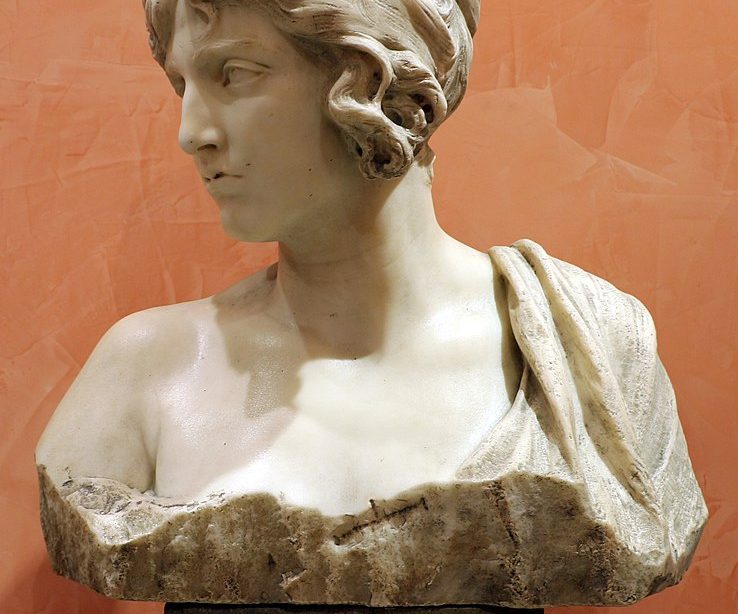As you may have noticed, this week is all about women of Greek Antiquity! On the Instagram, Facebook and Twitter, you can find posts dedicated to some of the most influential and famous women, but here on the website we are shining some light on a few great women from the Hellenistic Period. After Apama, the first queen of the Seleucids, guest blogger Hebe Kearney introduces us to Nossis, a female poet who lived in the third century BC.
Nossis was a female poet from Locris in Southern Italy [Balmer, 3]. She wrote in Greek and lived during the first half of the third century BCE [Balmer, 3; Licciardello, 435; Skinner (1991) and (2002), 69; Snyder, 77]. Eleven of her epigrams survive, and convey a strong poetic voice and interest in women’s lives and experiences, with eight of the eleven having women as subjects, and three mentioning Nossis herself by name.[Skinner (1991): 5; Snyder, 77]. There are also four references to Aphrodite, with the goddess positioned as a patron and inspiration for female poetic creation.[Skinner (2002) 63; Aphrodite often has a similar role in Sappho, and is mentioned in fourteen fragments].
Nossis was recognised even in antiquity for her focus on women, being awarded the epithet ‘θηλύγλωσσος’/‘thelyglossos’ by Antipater of Thessalonica [On the use of this epithet see: Skinner (1989): 14; Skinner (1991): 22; Rowland, 120] This epithet means essentially ‘one who spoke like a woman’ [Translation of the epithet here is following Skinner’s (1991): 22] The epithet is widely accepted as signalling Nossis’ poetic interest in and focus on women [Rowland, 120; Skinner (1991), 20; 22] Nossis, then, was a poet concerned with depicting women and women’s experiences.

To demonstrate Nossis’s poetic skill and self-proclaimed female poetic voice, let’s look at her poem In this poem, Nossis boldly declares that her poetry is woman-centred and highly skilled:
‘O stranger, if you indeed sail in the direction of Mytilene and its beautiful dances,
because you are inspired by the blossoming of Sappho’s graces,
say that the land of Locris bore one beloved both by her and the Muses,
and having learned that my name is Nossis: go!’
[Greek sourced from Paton (1917): 382-383; Translation is the author’s]
Sappho was a Greek poet who lived during the sixth century BC in Mytilene, a city on the island of Lesbos. She composed poetry about and for women, including love poetry. Her work was widely known and celebrated in antiquity, and she was hailed as ‘the tenth muse’. Her reputation has extended into modern times, and the terms ‘Sapphic’ and ‘lesbian’ are derived from her name and homeland respectively. In AP 7.718, Nossis uses her to symbolise female-authored poetry: she is positioned as the head of a female poetic tradition which Nossis claims to belong to. The poem lies within the Greek genre of ‘epitaphic’ poetry, which imitates inscriptions on tombstones. Often these poems are, like actual inscriptions, addressed to the reader on behalf of a deceased person. However, in AP. 7.718 there is no death, and the message is to be sent to Mytilene, not back to Nossis’s home in Locris. Instead of any mention of Nossis’ family or marital status, as one would expect, there is instead reference to Sappho. This poem therefore portrays female poetics as of central importance to Nossis’s life and identity. Nossis is proud of her poetic skill, and is not afraid to proclaim that this skill is influenced by and focused on women.
Nossis is therefore an interesting and important figure. Not only is she one of the few female poets from Greco-Roman antiquity whose work survives, but she is one that boldly embraces and celebrates her gender. Her work suggests that women writers in the Hellenistic period were aware of other women writers who came before them, and felt a connection to them across time. Nossis’s voice comes across to us as self-assured, triumphant even. This shows us that some women in antiquity were able to excel at pursuits normally dominated by men. Despite pervasive oppression that women in Greco-Roman antiquity faced, they were still at times able to create, feel solidarity with other women, and to celebrate this.
Futher reading
Balmer, Josephine. 2013. Piecing Together the Fragments: Translating Classical Verse, Creating Contemporary Poetry. Oxford: Oxford University Press. Oxford Scholarship Online. doi: 10.1093/acprof:oso/9780199585090.001.0001.
Licciardello, Flavia. 2016. ‘Nossis’ Auto-Epitaph: Analysing a Controversial Epigram.’ Acta Antiqua Academiae Scientiarum Hungaricae 56(4): 435-448. doi:10.1556/068.2016.56.4.3
Rowland, Johnathan, M. 2012. ‘Footnotes to Sappho: An Examination of the Female Poets of Greece.’ PhD Dissertation. The University of Michigan.
Nossis in The Greek Anthology, Volume II: Book 7: Sepulchral Epigrams. Translated by W. R. Paton. 1917. Cambridge, MA: Harvard University Press: 382-383.
Skinner, Marilyn. 1991. ‘Nossis Thelyglossos; The Private Text and the Public Book.’ In Women’s History and Ancient History. Sarah B. Pomeroy (ed). Chapel Hill: University of North Carolina Press: 20-47.
―――. 2002. ‘Aphrodite Garlanded:’ In Among Women: From the Homosocial to the Homoerotic in the Ancient World. Nancy S. Rabinowitz and Lisa Auanger (eds). Texas: University of Texas Press. 60-81.
Snyder, Jane M. 1989. The Woman and the Lyre: Women Writers in Classical Greece and Rome. Carbondale: Southern Illinois University Press.




